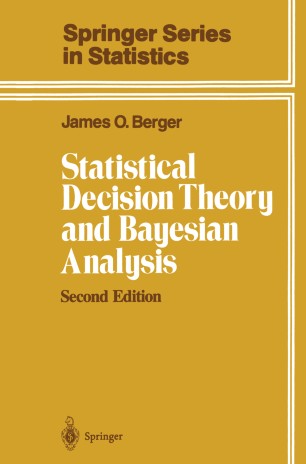Copies of the classnotes are on the internet in PDF format as given below. The "Proofs of Theorems" files were prepared in Beamer. The "Printout of Proofs" are printable PDF files of the Beamer slides without the pauses. These notes and supplements have not been classroom tested (and so may have some typographical errors).
ETSU does not have a formal class on Bayesian statistics.
Preface. Preface notes
Chapter 1. Basic Concepts.
- Section 1.1. Introduction. Section 1.1 notes
- Section 1.2. Basic Elements. Section 1.2 notes
- Section 1.3. Expected Loss, Decision Rules, and Risk.
- Section 1.4. Randomized Decision Rules.
- Section 1.5. Decision Principles.
- Section 1.6. Foundations.
- Section 1.7. Sufficient Statistics.
- Section 1.8. Convexity.
- Study Guide 1.
Chapter 2. Utility and Loss.
- Section 2.1. Introduction.
- Section 2.2. Utility Theory.
- Section 2.3. The Utility of Money.
- Section 2.4. The Loss Function.
- Section 2.5. Criticisms.
- Study Guide 2.
Chapter 3. Prior Information and Subjective Probability.
- Section 3.1. Subjective Probability.
- Section 3.2. Subjective Determination of the Prior Density.
- Section 3.3. Noninformative Priors.
- Section 3.4. Maximum Entropy Priors.
- Section 3.5. Using the Marginal Distribution to Determine the Prior.
- Section 3.6. Hierarchical Priors.
- Section 3.7. The Statistician's Role.
- Study Guide 3.
Chapter 4. Bayesian Analysis.
- Section 4.1. Introduction.
- Section 4.2. The Posterior Distribution.
- Section 4.3. Bayesian Inference.
- Section 4.4. Bayesian Decision Theory.
- Section 4.5. Empirical Bayes Analysis.
- Section 4.6. Hierarchical Bayes Analysis.
- Section 4.7. Bayesian Robustness.
- Section 4.8. Admissibility of Bayes Rules and Long Run Evaluations.
- Section 4.9. Bayesian Calculation.
- Section 4.10. Bayesian Communication.
- Section 4.11. Combining Evidence and Group Decisions.
- Section 4.12. Criticisms.
- Study Guide 4.
Chapter 5. Minimax Analysis.
- Section 5.1. Introduction.
- Section 5.2. Game Theory.
- Section 5.3. Statistical Games.
- Section 5.4. Classes of Minimax Estimators.
- Section 5.5. Evaluation of the Minimax Principle.
- Study Guide 5.
Chapter 6. Invariance.
- Section 6.1. Introduction.
- Section 6.2. Formulation.
- Section 6.3. Location Parameter Problems.
- Section 6.4. Other Examples of Invariance.
- Section 6.5. Maximal Invariants.
- Section 6.6. Invariance and Noninformative Priors.
- Section 6.7. Invariance and Minimaxity.
- Section 6.8. Admissibility of Invariant Rules.
- Section 6.9. Conclusions.
- Study Guide 6.
Chapter 7. Preposterior and Sequential Analysis.
- Section 7.1. Introduction.
- Section 7.2. Optimal Fixed Sample Size.
- Section 7.3. Sequential Analysis-Notation.
- Section 7.4. Bayesian Sequential Analysis.
- Section 7.5. The Sequential Probability Ratio Test.
- Section 7.6. Minimax Sequential Procedure.
- Section 7.7. The Evidential Relevance of the Stopping Rule.
- Section 7.8. Discussion of Sequntial Loss Functions.
- Study Guide 7.
Chapter 8. Complete and Essentially Complete Classes.
- Section 8.1. Preliminaries.
- Section 8.2. Complete and Essentially Complete Classes from Earlier Chapters.
- Section 8.3. One-Sided Testing.
- Section 8.4. Monotone Decision Problems.
- Section 8.5. Limits of Bayes Rules.
- Section 8.6. Other Complete and Essentially Complete Classes of Tests.
- Section 8.7. Complete and Essentially Complete Classes in Estimation.
- Section 8.8. Continuous Risk Functions.
- Section 8.9. Proving Admissibility and Inadmissibility.
- Study Guide 8.
Return to Bob Gardner's home page

